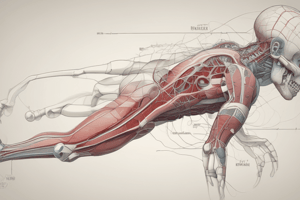Podcast
Questions and Answers
What is the primary function of the skeletal system?
What is the primary function of the skeletal system?
- To control and coordinate body functions
- To regulate body temperature
- To support the body and protect internal organs (correct)
- To bring oxygen into the body
Which type of neuron transmits sensory information?
Which type of neuron transmits sensory information?
- Interneuron
- Motor neuron
- Autonomic neuron
- Sensory neuron (correct)
What is the term for the process of breathing in?
What is the term for the process of breathing in?
- Respiration
- Inhalation (correct)
- Exhalation
- Inspiration
What type of muscle is responsible for involuntary movement?
What type of muscle is responsible for involuntary movement?
Which system is responsible for regulating body temperature?
Which system is responsible for regulating body temperature?
What is the function of the diaphragm?
What is the function of the diaphragm?
Which bone type includes the femur and humerus?
Which bone type includes the femur and humerus?
What is the primary function of the nervous system?
What is the primary function of the nervous system?
What is the term for the process of breathing out?
What is the term for the process of breathing out?
Which system is responsible for producing blood cells?
Which system is responsible for producing blood cells?
Flashcards are hidden until you start studying
Study Notes
Skeletal System
- Functions:
- Supports the body
- Protects internal organs
- Provides movement through joint articulation
- Produces blood cells
- Stores minerals (e.g. calcium, phosphorus)
- Components:
- Bones (206 in adult human skeleton)
- Joints (connect bones)
- Ligaments (connect bones to each other)
- Tendons (connect muscles to bones)
- Types of bones:
- Long bones (e.g. femur, humerus)
- Short bones (e.g. carpals, tarsals)
- Flat bones (e.g. ribs, sternum)
- Irregular bones (e.g. vertebrae, pelvis)
Nervous System
- Functions:
- Controls and coordinates body functions
- Interprets and responds to sensory information
- Regulates body temperature, hunger, and thirst
- Components:
- Central nervous system (CNS): brain and spinal cord
- Peripheral nervous system (PNS): nerves
- Somatic nervous system: controls voluntary movements
- Autonomic nervous system: controls involuntary movements
- Types of neurons:
- Sensory neurons: transmit sensory information
- Motor neurons: transmit motor signals
- Interneurons: integrate and process information
Respiratory System
- Functions:
- Brings oxygen into the body
- Removes carbon dioxide from the body
- Components:
- Upper respiratory tract: nose, mouth, pharynx, larynx
- Lower respiratory tract: trachea, bronchi, lungs
- Diaphragm: muscle that separates chest and abdominal cavities
- Process of breathing:
- Inhalation: diaphragm contracts, air enters lungs
- Exhalation: diaphragm relaxes, air leaves lungs
Muscular System
- Functions:
- Moves body parts
- Maintains posture
- Regulates body temperature
- Supports movement of other systems (e.g. circulatory, respiratory)
- Types of muscles:
- Skeletal muscles: voluntary movement
- Smooth muscles: involuntary movement (e.g. digestive tract)
- Cardiac muscles: involuntary movement (e.g. heart)
- Muscle structure:
- Muscle fibers: contractile units
- Muscle cells: contain multiple fibers
Circulatory System
- Functions:
- Transports oxygen and nutrients to cells
- Removes waste products from cells
- Regulates body temperature
- Components:
- Heart: pumps blood
- Arteries: carry oxygenated blood away from heart
- Veins: carry deoxygenated blood back to heart
- Blood vessels: capillaries, arterioles, venules
- Blood components:
- Plasma: liquid portion
- Red blood cells: carry oxygen
- White blood cells: immune function
- Platelets: clotting function
Skeletal System
- Provides support, protection, and movement for the body
- Produces blood cells and stores minerals like calcium and phosphorus
- Consists of 206 bones, joints, ligaments, and tendons in an adult human skeleton
- Bones are categorized into long bones (e.g. femur, humerus), short bones (e.g. carpals, tarsals), flat bones (e.g. ribs, sternum), and irregular bones (e.g. vertebrae, pelvis)
Nervous System
- Controls and coordinates body functions, interprets sensory information, and regulates body temperature, hunger, and thirst
- Comprises the central nervous system (brain and spinal cord), peripheral nervous system (nerves), somatic nervous system (voluntary movements), and autonomic nervous system (involuntary movements)
- Neurons are categorized into sensory neurons (transmit sensory information), motor neurons (transmit motor signals), and interneurons (integrate and process information)
Respiratory System
- Brings oxygen into the body and removes carbon dioxide
- Consists of the upper respiratory tract (nose, mouth, pharynx, larynx), lower respiratory tract (trachea, bronchi, lungs), and diaphragm (separates chest and abdominal cavities)
- The process of breathing involves inhalation (diaphragm contracts, air enters lungs) and exhalation (diaphragm relaxes, air leaves lungs)
Muscular System
- Enables movement, maintains posture, regulates body temperature, and supports movement of other systems
- Comprises skeletal muscles (voluntary movement), smooth muscles (involuntary movement, e.g. digestive tract), and cardiac muscles (involuntary movement, e.g. heart)
- Muscles are composed of muscle fibers (contractile units) and muscle cells (contain multiple fibers)
Circulatory System
- Transports oxygen and nutrients to cells, removes waste products, and regulates body temperature
- Consists of the heart (pumps blood), arteries (carry oxygenated blood away from heart), veins (carry deoxygenated blood back to heart), and blood vessels (capillaries, arterioles, venules)
- Blood components include plasma (liquid portion), red blood cells (carry oxygen), white blood cells (immune function), and platelets (clotting function)
Studying That Suits You
Use AI to generate personalized quizzes and flashcards to suit your learning preferences.




